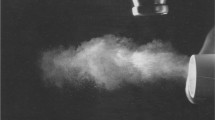Abstract
Droplet velocity is an important parameter that can be used to characterize nasal spray products. In this study, a phase-Doppler anemometry (PDA) system was used to measure the droplet velocities of nasal sprays. A survey of seven commercial nasal spray products showed a range of droplet velocities from 6.7 to 19.2 m/s, all significantly different from each other. A three-level, four-factor Box–Behnken design of experiments (DOE) methodology were applied to investigate the influences of actuation parameters and formulation properties on nasal spray droplet velocity using a set of placebo formulations. The DOE study shows that all four input factors (stroke length, actuation velocity, concentration of the gelling agent, and concentration of the surfactant) have significant influence on droplet velocity. An optimized quadratic model generated from the DOE results describes the inherent relationships between the input factors and droplet velocity thus providing a better understanding of the input factor influences. Overall, PDA provides a new in vitro characterization method for the evaluation of inhalation drugs through assessment of spray velocity and may assist in product development to meet drug delivery equivalency requirements.



Similar content being viewed by others
References
U.S. Food and Drug Administration. Draft guidance for industry: metered dose inhaler (MDI) and dry powder inhaler (DPI) drug products. 1998.
U.S. Food and Drug Administration. Guidance for industry: nasal spray and inhalation solution, suspension, and spray drug products—chemistry, manufacturing, and controls documentation. 2002.
U.S. Food and Drug Administration. Draft guidance for industry: bioavailability and bioequivalence studies for nasal aerosols and nasal sprays for local action. 2003.
Guo C, Doub WH. Development of a novel technology to measure impaction force of nasal sprays and metered dose inhalers using the texture analyser. In: Byron PR, Peart J, Suman JD, Farr SJ, Dalby RN, editors. Respiratory drug delivery. River Grove: Davis Healthcare International Publishing; 2006. p. 621–4.
Guo C, Ye W, Kauffman JF, Doub WH. Evaluation of impaction force of nasal sprays and metered-dose inhalers using the texture analyser. J Pharm Sci. 2009;98(8):2799–806.
Liu X, Doub WH, Guo C. Evaluation of droplet velocity and size from nasal spray devices using phase Doppler anemometry (PDA). Int J Pharm. 2010;388(1–2):82–7.
Albrecht H-E, Damaschke N, Borys M, Tropea C. Laser Doppler and phase Doppler measurement techniques. In: Merzkirch, Wolfgang, Rockwell, Donald, Tropea, Cameron, editors. Experimental fluid mechanics, ed. New York: Springer-Verlag Berlin Heidelberg; 2003. p. 738.
Dayal P, Shaik M, Singh M. Evaluation of different parameters that affect droplet-size distribution from nasal sprays using the Malvern Spraytec. J Pharm Sci. 2004;93:1725–42.
Guo C, Doub WH. The influence of actuation parameters on in vitro testing of nasal spray products. J Pharm Sci. 2006;95:2029–40.
Dayal P, Pillay V, Babu, JR, Singh, M. Box-Behnken experimental design in the development of a nasal drug delivery system of model drug hydroxyurea: characterization of viscosity, in vitro drug release, droplet size, and dynamic surface tension. AAPS PharmSciTech. 2005; 6(4):Article 72.
Guo C, Stine KJ, Kauffman JF, Doub WH. Assessment of the influence factors on in vitro testing of nasal sprays using Box-Behnken experimental design. Eur J Pharm Sci. 2008;35(12):417–26.
Takeuchi G, Kawaguchi T, Hishida K, Maeda M, Sommerfeld, M. Spatial distributions of droplet size and velocity in air heated spray measured by interferometric laser imaging technique. 12th International Symposium on Applications of Laser Techniques to Fluid Mechanics, ed., Lisbon, Portugal. 2004.
Acknowledgment
This work was supported by the U.S. Food and Drugs Administration through its Critical Path Initiative fund (Project #1165).
Author information
Authors and Affiliations
Corresponding author
Additional information
The findings and conclusions in this article have not been formally disseminated by the Food and Drug Administration and should not be construed to represent any agency determination or policy.
Rights and permissions
About this article
Cite this article
Liu, X., Doub, W.H. & Guo, C. Assessment of the Influence Factors on Nasal Spray Droplet Velocity Using Phase-Doppler Anemometry (PDA). AAPS PharmSciTech 12, 337–343 (2011). https://doi.org/10.1208/s12249-011-9594-1
Received:
Accepted:
Published:
Issue Date:
DOI: https://doi.org/10.1208/s12249-011-9594-1




